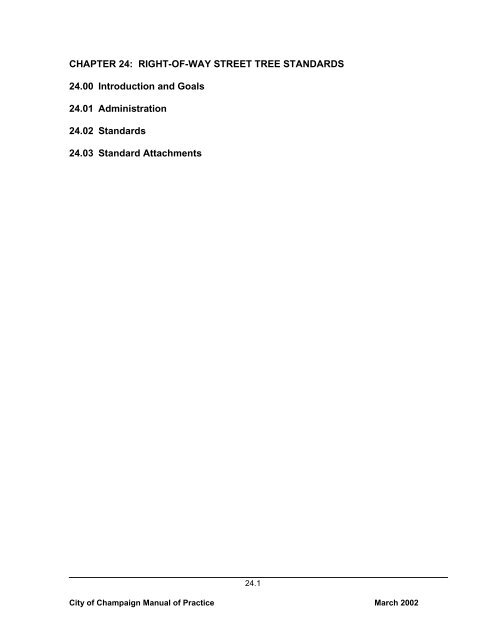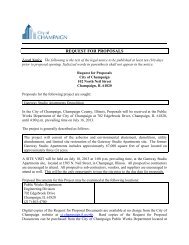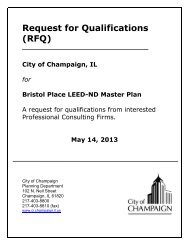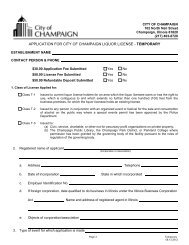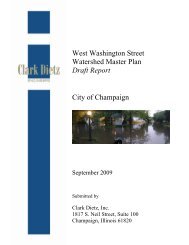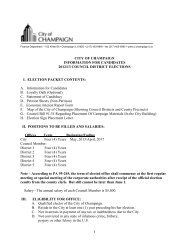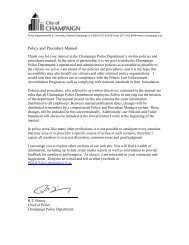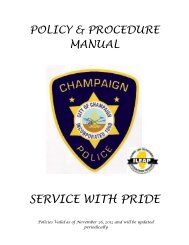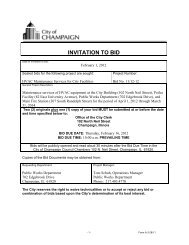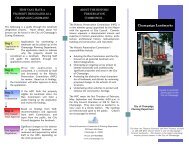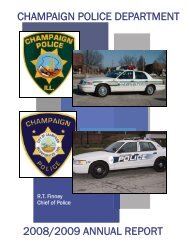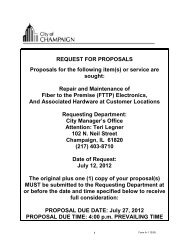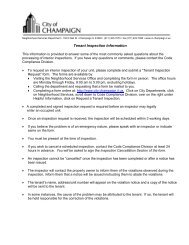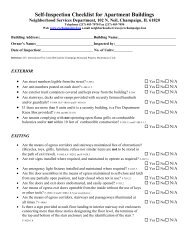Chapter 24 Right-of-way Street Tree Standards - City of Champaign
Chapter 24 Right-of-way Street Tree Standards - City of Champaign
Chapter 24 Right-of-way Street Tree Standards - City of Champaign
- No tags were found...
Create successful ePaper yourself
Turn your PDF publications into a flip-book with our unique Google optimized e-Paper software.
CHAPTER <strong>24</strong>: RIGHT-OF-WAY STREET TREE STANDARDS<strong>24</strong>.00 Introduction and Goals<strong>24</strong>.01 Administration<strong>24</strong>.02 <strong>Standards</strong><strong>24</strong>.03 Standard Attachments<strong>24</strong>.1<strong>City</strong> <strong>of</strong> <strong>Champaign</strong> Manual <strong>of</strong> Practice March 2002
CHAPTER <strong>24</strong>: RIGHT-OF-WAY STREET TREE STANDARDS<strong>24</strong>.00 INTRODUCTION AND GOALSThe goal <strong>of</strong> this chapter is to promote the health and development <strong>of</strong> the Urban Forest in the <strong>City</strong><strong>of</strong> <strong>Champaign</strong> in a manner that increases the value <strong>of</strong> real property and improves the quality <strong>of</strong>life in the <strong>City</strong>.<strong>24</strong>.01 ADMINISTRATIONA. All new subdivisions within the <strong>City</strong> limits and within the 1-1/2 mile extra territorialjurisdiction shall have street trees installed on the right-<strong>of</strong>-<strong>way</strong> per the requirements withinthese standards.B. <strong>Tree</strong> planting will be accomplished at developer cost through one <strong>of</strong> the following means:1. Developer installation.2. <strong>City</strong> installation: The <strong>City</strong> will require a payment <strong>of</strong> $300.00 per tree to contract fornew subdivision planting. (This cost will be subject to change to accommodate futureprice changes.)C. A tree-planting permit obtained from the Public Works Department Forestry Supervisor willbe required prior to planting (see Standard Attachment <strong>24</strong>.01).<strong>24</strong>.02 STANDARDSA. Introduction: The following outlines the permit requirements, standards and procedures forplanting trees on the <strong>City</strong> right-<strong>of</strong>-<strong>way</strong>.B. <strong>Standards</strong> and Procedures:1. Subdivision Planting <strong>Standards</strong>:a. <strong>Tree</strong>s shall be planted at least one every 60 ft., with a minimum <strong>of</strong> one per lot.b. The park<strong>way</strong> must be 6 ft. or more in width.c. <strong>Tree</strong>s must be 10 ft. from drive<strong>way</strong>s, alleys and fire hydrants.d. <strong>Tree</strong>s must be 35 ft. from intersection curb line.e. The planting site should be free <strong>of</strong> overhanging crown growth from trees growing<strong>of</strong>f the right-<strong>of</strong>-<strong>way</strong>.f. <strong>Tree</strong>s must be approved species (see Standard Attachment <strong>24</strong>.02).g. <strong>Tree</strong>s planted under or next to utility lines must be <strong>of</strong> species and cultivars whoseheight at maturity will not interfere with these lines. Large trees plantedadjacent to overhead lines should be planted a minimum <strong>of</strong> 30 ft. from overheadlines.h. Planting trees on the <strong>City</strong> right-<strong>of</strong>-<strong>way</strong> prior to construction will not be permittedwith the exception <strong>of</strong> medians that will not be affected by construction activities.Problems arising from drive<strong>way</strong> placement and construction disturbances totrees make pre-construction planting a poor choice.<strong>City</strong> <strong>of</strong> <strong>Champaign</strong> Manual <strong>of</strong> Practice March 2002<strong>24</strong>.2
CHAPTER <strong>24</strong>: RIGHT-OF-WAY STREET TREE STANDARDS2. <strong>Tree</strong> Planting Procedures for all Locations (including Subdivisions):a. The planting hole should be <strong>24</strong> in. – 36 in. larger in diameter than the diameter <strong>of</strong>the root ball, and the root balls shall be placed on undisturbed subgrade toprevent settling.b. The root flare, where roots spread at the tree base, should al<strong>way</strong>s be at theground line. Often, nurseries mound soil around the tree base above the rootflare. When bailed with burlap, the basal flare is hidden. If the tree is plantedwith the top <strong>of</strong> the ball at ground line, the tree will have been planted too deeply.c. The twine holding the burlap around the ball must be cut and the burlap loosenedfrom around the top <strong>of</strong> the ball. Wire baskets shall be removed from the topone-half <strong>of</strong> the root ball prior to backfilling.d. The hole should be backfilled and gently tamped so that no air pockets are leftaround the ball. Backfill soil should not be amended unless planting in buildingrubble, poor or severely disturbed soils.e. The trunks should be vertical after planting.f. Excess soil should be removed from the site and a 3 in. to 4 in. thick layer <strong>of</strong>wood chip mulch placed around the base <strong>of</strong> the tree. Avoid placing wood chipmulch directly in contact with the trunk.g. <strong>Tree</strong>s should be watered at the time <strong>of</strong> planting and regularly thereafter asneeded.h. Staking is not typically recommended; however, when necessary, follow currentrecommendations <strong>of</strong> <strong>City</strong> Forester. Wire in a hose is unacceptable.i. Plants should be pruned after planting only to remove broken or dead branches.3. Quality <strong>of</strong> <strong>Tree</strong>s:a. All trees must be true to species, variety, and/or cultivar, and each plant must belabeled when delivered.b. All trees must have normal trunks, leaders, tops and branches typical <strong>of</strong> thespecies, variety, or cultivar, and exhibit evidence <strong>of</strong> proper nursery pruningpractices.c. All trees must be certified free <strong>of</strong> insect pests and diseases by the Department <strong>of</strong>Agriculture, Division <strong>of</strong> Entomology, State <strong>of</strong> Illinois.d. All trees must be free <strong>of</strong> mechanical injuries and not show evidence <strong>of</strong> recent orprevious wounds on the trunk.e. All trees must be nursery grown and must have received proper fertilizing,watering, top and root pruning as is normally needed for that particular kind <strong>of</strong>tree. Plants must have been grown in nursery conditions for the past two yearsunder soil and climate conditions similar to that <strong>of</strong> <strong>Champaign</strong>, Illinois.f. All plants must be balled and burlapped. The twine used to tie the burlap mustnot be plastic. The balls should be <strong>of</strong> firm earth from the original soil in which<strong>City</strong> <strong>of</strong> <strong>Champaign</strong> Manual <strong>of</strong> Practice March 2002<strong>24</strong>.3
CHAPTER <strong>24</strong>: RIGHT-OF-WAY STREET TREE STANDARDSthe tree grew in the nursery. No trees with broken, loose or manufactured ballsare acceptable.g. <strong>Tree</strong>s on the list <strong>of</strong> approved species must have trunks at least 2 in. in diametermeasured 6 in. above the ground, and a soil ball <strong>of</strong> at least <strong>24</strong> in. in diameter.h. <strong>Tree</strong>s shall be guaranteed for a period <strong>of</strong> one year following planting.4. Approved Species: Refer to the Approved Species List incorporated herein (seeStandard Attachment <strong>24</strong>.02).<strong>24</strong>.03 STANDARD ATTACHMENTS:Standard Attachment Number <strong>24</strong>.01 – Permit FormStandard Attachment Number <strong>24</strong>.02 – Approved Species List<strong>City</strong> <strong>of</strong> <strong>Champaign</strong> Manual <strong>of</strong> Practice March 2002<strong>24</strong>.4
CHAPTER <strong>24</strong>: RIGHT-OF-WAY STREET TREE STANDARDSCITY OF CHAMPAIGNPUBLIC WORKS / FORESTRY SECTION702 Edgebrook Dr., <strong>Champaign</strong>, Illinois 61820TREE PLANTING AND MAINTENANCE PERMITPermit or approval to perform tree maintenance or planting <strong>of</strong> trees on <strong>City</strong> right-<strong>of</strong>-<strong>way</strong>.APPLICANT ONLY - Please provide the following information:Standard Attachment <strong>24</strong>.01Name:______________________________________________________________________Address:____________________________________________________________________Telephone Number:___________________________________________________________Work Site Location:______________________________________________________________________________________________________________________________________Type <strong>of</strong> tree work/planting/treatment involved:__________________________________________________________________________________________________________________Proposed species to be planted:_________________________________________________For tree planting, please indicate approximate location usingdimensions in relation to other lot features (e.g. drive<strong>way</strong>, existingtrees, corner, etc.) A rough sketch to illustrate location is helpful.(Please use the space to the right.)A J.U.L.I.E. locate is necessary before apermit for planting is granted. J.U.L.I.E.can be reached at (800) 892-0123.J.U.L.I.E. dig number:__________________Applicant Signature:_______________________________Date:______________________ Approved ____ Not Approved Permit No. ______________Additional comments or conditions:____________________________________________________________________________________________________________________________Approved by:___________________________________<strong>City</strong> ForesterDate:__________________Standard Attachment <strong>24</strong>.01<strong>City</strong> <strong>of</strong> <strong>Champaign</strong> Manual <strong>of</strong> Practice March 2002
CHAPTER <strong>24</strong>: RIGHT-OF-WAY STREET TREE STANDARDSTREES THAT MAY BE PLANTED ALONG PUBLICRIGHTS-OF-WAY IN CHAMPAIGNSmall <strong>Tree</strong>s:Note: Small trees only permitted for use where overhead restrictions exist (i.e., utility lines).Crabapple(cultivars resistant to apple scab)Hawthorn (thornless)HornbeamCorneliancherry dogwood Japanese tree lilac RedbudKousa dogwood Amur maple ServiceberryLaurel magnoliaLoebner magnoliaPagoda dogwood Paperbark maple Carolina silverbellTatarian maple<strong>Tree</strong> form viburnumMedium to Large <strong>Tree</strong>s:Black alder Sugar hackberry Bur oakBlue ash European hornbeam Chinkapin oakWhite ash Ironwood Overcup oakBaldcypress Katsura Red oakBasswood Crimean linden Shingle oakAmerican beech Littleleaf linden Swamp white oakEuropean beech Silver linden White oakAmur corktree Cucumbertree magnolia Dawn redwoodElm Black maple Hardy rubber tree(cultivars resistant to Dutch elm disease) Freeman maple SassafrasTurkish filbert Hedge maple TuliptreeGinkgo (male)GoldenraintreeMiyabe mapleRed mapleBlack tupeloYellowoodHackberry Sugar maple Japanese zelkovaTREES THAT MAY NOT BE PLANTED ALONG PUBLICRIGHTS-OF-WAY IN CHAMPAIGNApple Siberian elm Russian oliveArborvitae Slippery elm Osage orangeGreen ash Empress tree PeachMountain ash Fir PearRiver birch Hemlock Callery pearWhite birch Hickory PecanBoxelder Honeylocust PineOhio buckeye Horsechestnut PlumButternut Juniper PoplarCatalpa Black locust SpruceCedar Nor<strong>way</strong> maple SweetgumCherry Silver maple SycamoreChestnut Mimosa tree <strong>Tree</strong> <strong>of</strong> HeavenCottonwood Mulberry WalnutFlowering dogwood Pin oak WillowAmerican elmScarlet oakStandard Attachment <strong>24</strong>.02<strong>City</strong> <strong>of</strong> <strong>Champaign</strong> Manual <strong>of</strong> Practice March 2002


